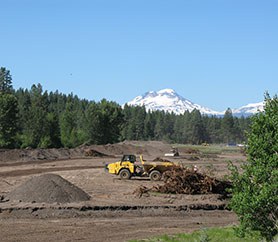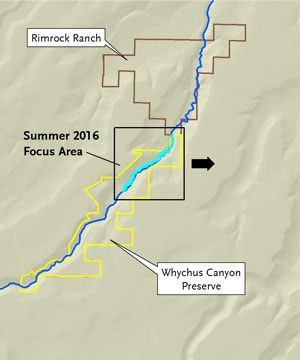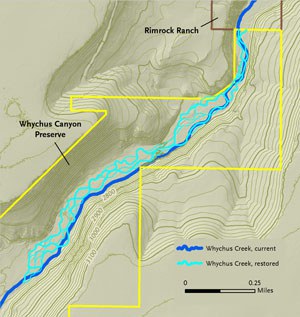 **August 2016 Update: The restoration is underway! Read updates on the project.
**August 2016 Update: The restoration is underway! Read updates on the project.
This summer the bulldozers and planting crews will be returning to a Land Trust Preserve on Whychus Creek. It is a visible reminder that sometimes nature needs a little help to get back on her feet. This time our efforts will be focused on Whychus Canyon Preserve and the start of an ambitious six-mile, multi-year Whychus Creek restoration project.
Why restore Whychus Creek?
The 930-acre Whychus Canyon Preserve protects four miles of Whychus Creek. Like other long stretches of this creek, the portion that passes through the Preserve has been straightened, pushed to the far edge of its valley floor, and bermed to keep it in place. This in turn diminished fish and wildlife habitat in and along the creek.
Historically, Whychus Creek was mixture of narrow canyon stretches, and stretches with broad, level meadows where the creek could spill over its banks. The biological importance of these large meadows was huge, especially considering all the arid land surrounding them. They provided diverse stream and side channel habitats for fish to spawn, rear, and hide. Streamside vegetation provided cover for wildlife and helped cool stream waters. Nearby wetlands and oxbows were home to amphibians and songbirds.  Only a small portion of the total length of the creek can provide this critical meadow habitat. Camp Polk Meadow Preserve is one of these special sections and Whychus Canyon Preserve and Rimrock Ranch are another. Our goal in restoring the creek through these valuable stretches is to return the creek to its historic, biologically diverse condition.
Only a small portion of the total length of the creek can provide this critical meadow habitat. Camp Polk Meadow Preserve is one of these special sections and Whychus Canyon Preserve and Rimrock Ranch are another. Our goal in restoring the creek through these valuable stretches is to return the creek to its historic, biologically diverse condition.
How will the restoration happen?
Given the size and scale of the restoration, work will occur in phases over multiple years. This first phase will focus on approximately 1.5 miles of Whychus Creek in the northernmost part of Whychus Canyon Preserve.
Much of the work will be similar to the recent Camp Polk Meadow Preserve restoration. Crews will remove berms that are holding the stream in its current straight alignment, they will carve out soil in some areas and fill it in in others to promote the free movement of water across its historic floodplain. Large woody debris (like whole trees) will be added to create complex habitat for fish and wildlife. Then, more than 60,000 native trees, shrubs, wildflowers and grasses will be planted and seeded to provide stream shade, bank and floodplain stability, and habitat for wildlife.  A couple elements that will be different from the Camp Polk Meadow Preserve restoration are the planned braided stream channel design and the timing of the plantings. At Camp Polk Meadow, one main restoration channel was carved and several miles of side channels were connected to it as a supporting network. At Whychus Canyon, we’ll carve multiple channels, many of them following old pathways where water once flowed and where mature vegetation still stands. When water levels are high, the creek will utilize all of these pathways and will likely carve additional, natural pathways as time goes on. When water levels are low, the creek will flow through a subset of the braided system. This multiple channel approach provides a great deal of habitat diversity across the meadow.
A couple elements that will be different from the Camp Polk Meadow Preserve restoration are the planned braided stream channel design and the timing of the plantings. At Camp Polk Meadow, one main restoration channel was carved and several miles of side channels were connected to it as a supporting network. At Whychus Canyon, we’ll carve multiple channels, many of them following old pathways where water once flowed and where mature vegetation still stands. When water levels are high, the creek will utilize all of these pathways and will likely carve additional, natural pathways as time goes on. When water levels are low, the creek will flow through a subset of the braided system. This multiple channel approach provides a great deal of habitat diversity across the meadow.
The timing of creekside plantings will also be different. At Camp Polk Meadow Preserve, we carved the restored channels, planted vegetation, and then waited for several years before releasing the full flow of Whychus creek into the restored channels. Because we’re restoring this next six-mile stretch of Whychus Creek in phases and shorter sections, we’ll create the new channels, release water into them, and plant the banks and floodplain all at the same time.
Phase I, this initial work on 1.5 miles of Whychus Creek at Whychus Canyon Preserve, will start in this summer and run through the fall. Then the project area will be left alone to rest, recover, and naturally evolve and growth. Or, as we like to say, sleep, creep, then leap! Phase II, which includes the portion of Whychus Creek upstream of Phase I, is planned for 2017 or 2018.
Who is doing the restoration?
The Land Trust has partnered with the Upper Deschutes Watershed Council and the Deschutes National Forest on this restoration project. Additionally, a project advisory committee has provided design review and specific scientific expertise where needed. Members of this group include representatives from Oregon Department of Fish & Wildlife, U.S. Fish & Wildlife Service, U.S. Forest Service, Confederated Tribes of Warm Springs Reservation, Portland General Electric, Bureau of Land Management, NOAA Fisheries, and Oregon Department of Environmental Quality.
Learn more about the restoration:
- Join us for a restoration tour this spring, summer and fall.
- Read the executive summary about the project from the Upper Deschutes Watershed Council.
- Contact the Land Trust or Upper Deschutes Watershed Council with more questions.


